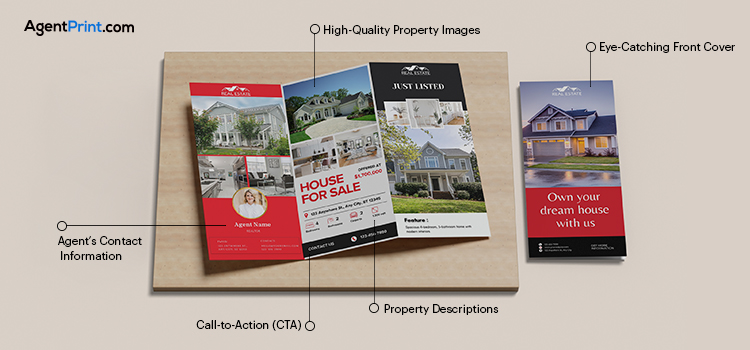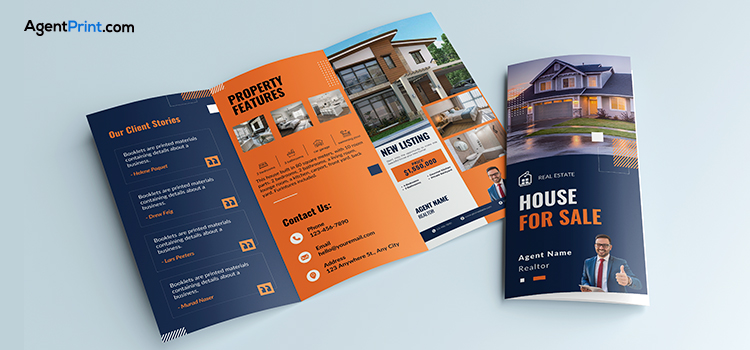Even in today’s digital age, dominated by online ads and social media, printed real estate brochures are still viable tools in supporting your overall marketing strategy. Your real estate business connects with potential customers through the first impression they have of your business brochures. The first printed material customers encounter from your company helps form their first impression and determines further engagement.
Brochures are cheaper than magazines, billboards, and radio and TV ads for businesses. You can use real estate brochure content with eye-catching images and the property’s key details to grab the customers’ attention. The different parts of such a brochure must point out key selling features and benefits. Keep reading to find out more about how to create winning real estate brochure content.
Why a Well-Designed Real Estate Brochure Matters
Real estate agents create marketing materials to attract potential buyers through real estate listings. The primary tool used by real estate brokers to highlight the advantages and noteworthy features of properties is the brochure. The property’s visual media and details, including its exact location and selling points, are presented in the brochure.
Excellent real estate brochures let you show properties clearly while making connections with your customers. Creating an effective brochure is important because of these main benefits:
- Trust and Credibility: A polished brochure assures potential clients that the real estate agency delivers quality results and professional service.
- Support Branding: They maintain brand consistency by displaying familiar visual designs and helping customers recognize the agency for its premium offerings.
- Visual Appeal: Brochures work best when they display beautiful images and sharp photos of the home because they help people better imagine living in it.
- Detailed Information: Brochures let buyers see floor plans and learn about the property in detail through written descriptions.
- Tangible and Memorable: The physical nature of printed brochures helps clients keep and review information and remember the property and the real estate agency.
- Affordable and Effective: Using brochures to market properties helps agencies reach many customers at a lower cost than other marketing methods.
- Complementing Digital Marketing: Brochures help digital marketing by letting clients touch base with printed information after viewing properties online.
- Versatility: Brochures offer flexibility to market properties across different distribution methods such as direct mail, office desks, or event boards. By targeting different channels, the company reaches more people to promote its properties.
Essential Parts of a Real Estate Brochure

A properly designed brochure shows the agent’s expertise while presenting property details to customers. An attractive property brochure helps both buyers understand its market value and sellers deliver their property’s potential. This section explains the key details you should include in your brochures:
Eye-Catching Front Cover
The effectiveness of brochure covers as first impressions directly determines whether readers will hold on to read the material. An eye-grabbing design that indicates brand identity should draw readers toward the brochure to explore further. The quality of both the product and the service is reflected through an excellent cover design.
Compelling Property Descriptions
The brochure provides fundamental property information, which allows potential buyers to quickly understand what awaits them. This part establishes key listing characteristics, including property type and dimensions and its set price. The brochure content should mention special characteristics to help potential buyers develop emotional connections. A modern kitchen, swimming pool installations, or energy-efficient appliances are features that could influence a buying decision.
High-Quality Property Images
Most individuals immediately focus on photos when they see something. Quality images naturally attract views while establishing immediate positive feelings in customers. The combination of good design and visual appeal will improve both brochure memory retention and appeal to readers. Your visual collection should feature essential house locations, including bedrooms, living areas, kitchens, bathrooms, and outside areas.
Agent’s Contact Information
Include the real estate agent’s or office’s contact details, including the phone number, email address, and website. Give your potential customers straightforward ways to start conversations about your listings and book their site visits.
Call-to-Action (CTA)
Direct your clients to take action through distinct instructions, such as messaging the agent for details or arranging a tour.
These are the main factors affecting the appealing look of your brochure. If you are looking for more design-related tips, go to this page and read some expert tips to design a stunning real estate brochure.
Best Practices for Writing Real Estate Brochure Content
Never underestimate the importance of the first impression. Too many real estate brochures lead people to quickly dismiss any brochures that look dull or contain excessive information. Simplicity stands as an essential element while adding beautiful images and relevant templates. Keep in mind the following practices:
- An impressive headline: Research shows that human brains can focus on one thing for only 8 seconds at a time. So, your brochure content will become more effective when you choose an attention-grabbing headline. You should compose headlines specifically for your target audience.
- Write simply but to the point: when crafting real estate brochure content, use essential property elements. Write only about pricing, event scheduling, specific amenities, and contact info. Don’t bore the reader with lengthy sections of unnecessary information.
- Include website and social media profiles: The distribution of printed brochures helps generate brand awareness while directing customers towards your website. It proves beneficial to put your social media profiles in brochures to boost both your audience reach and engagement potential. You can even add a QR code for easy access.
- Consider your objectives: Your intent with the brochure is to either speed up the property sale process or create publicity throughout the community. The goals you established should guide your entire brochure design and content.
- Talk about yourself: Your brochure serves as an excellent platform for showcasing your business character and mission as a communication device. A business brochure should talk about your mission or what distinct qualities set you apart from competitors.
Common Mistakes to Avoid in Real Estate Brochures
❌Too much information. The majority of brochures contain extensive textual content. Text functions as one tool among many to create powerful effects in content creation. Your brochure should focus on essential information, showcasing what makes the property stand out from others.
❌Poor photos. Poor resolution, combined with weak photo composition, negatively affects how property attributes are presented to potential buyers. Select premium property photography through which you can highlight all the property’s strongest characteristics.
❌Incorrect Information. Parts of a real estate brochure must include precise data and up-to-date property information. Perform a double check of all information while making sure you update it as soon as possible.
❌Poor Communication. Try to maintain effective communication with clients throughout every stage of the process. Stay responsive to your clients’ questions while regularly informing them of updated information.
How to Customize Your Real Estate Brochure for Different Property Types
The initial step to customize a brochure for specific properties involves studying their unique elements and their intended customer profile. Designed content and presentation elements within the brochure must emphasize key features to engage targeted audiences. Consider the following recommendations:
- Luxury properties: Try to emphasize the upscale amenities, like modern kitchens, custom finishes, extensive exterior areas, and elite amenities packages.
- Condos: Properties located in condominiums need to showcase their urban lifestyle and community environment with their easy access to local amenities.
- Family Homes: When selling family homes, you should promote spacious design with modern kitchens and proximity to desired schools.
- Townhouses: Showcase townhouses by emphasizing the advantages of independent homes with condo accessibility.
- Commercial properties: Highlight their strategic location as well as dimensions, possible business development capabilities, and easy accessibility.
- Ranches/Land: Showcase the area of land, natural beauty, rural living, and potential for development.
In the end, the most important decision is to choose a reliable and professional printing company to make sure about the final quality of your brochure content. AgentPrint.com is ready to assure you of high-quality results for your printed marketing materials.
Final Words
Your real estate brochure functions beyond listing properties with aesthetic images. It clearly demonstrates your skill level and valuable service to clients. The various parts of a real estate brochure function as one united whole to capture buyers’ attention with attractive content. Each brochure you distribute must deliver impactful content and a stylish design for trust establishment and more successful closings. Use your brochures as strategic tools that drive your real estate business’s progress.
